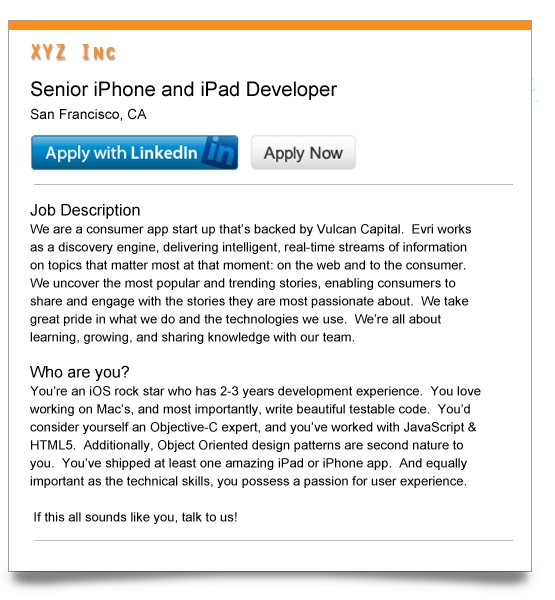Just before lunchtime in New York City, LinkedIn announced it is offering employers a button to include on all their job postings enabling candidates to use their LinkedIn profiles to apply for the position.
This “Apply With LinkedIn” feature wraps up the candidate profile in a tidy package that feeds directly into any one of the several tracking systems it has or will partner with. No ATS? No problem. LinkedIn will email the profile to you.
This portable feature can be used on any job, anywhere, on any site, including any job board.
Five ATS providers — Peoplefluent, Jobvite, SmartRecruiters, Bullhorn, and Jobscience — turned on the automatic feature this morning. Taleo, Lumesse, and Kenexa will have it enabled in a matter of months.
However, as LinkedIn’s VP of product management, Adam Nash, explained, the company designed the “apply” feature to be used by small, as well as large employers. It’s “really trivial” for a hiring manager at even the smallest of firms to add the button to a job posting, and specify how and where the resume is to be received.
 Even candidates with resumes already on file with a job board may find the LinkedIn apply feature of more use, since it allows them to update their LinkedIn profile before submitting it, and also tells them who in their network works or knows someone at the company.
Even candidates with resumes already on file with a job board may find the LinkedIn apply feature of more use, since it allows them to update their LinkedIn profile before submitting it, and also tells them who in their network works or knows someone at the company.
Those who click the link without having a profile — a not-too-common occurrence given the 100 million members LinkedIn has — will be given an opportunity to join.
Candidates can always opt to use some other source for their resume submission, Nash said. “This won’t be the only option there,” he said. If, though, recruiters begin to use the “apply” button in numbers, job seekers will find it easier to keep one profile updated, than the 12.6 LinkedIn says the average seeker has.
“Users,” he added, “will vote with their clicks.”
Its one major drawback is that it doesn’t yet work with smartphones. It will with some portable devices such as an iPad. Full mobile compatibility is coming, Nash promised.
 “Apply With LinkedIn” has very definite consequences for job boards, which derive a third or more of their revenue from resume searching. Almost two months ago Dan Schawbel wrote about the feature, still then under wraps. Touting the advantages of the plug-in, he said, “Job boards and traditional resumes are going to fade faster than I even predicted!”
“Apply With LinkedIn” has very definite consequences for job boards, which derive a third or more of their revenue from resume searching. Almost two months ago Dan Schawbel wrote about the feature, still then under wraps. Touting the advantages of the plug-in, he said, “Job boards and traditional resumes are going to fade faster than I even predicted!”
This morning, I emailed three of the largest job boards for their reaction. I haven’t yet heard from any of them, but I can’t imagine this is a development they’re welcoming. Corporate career sites, search engines, and social media all have impacted the pay-to-post business of job boards. Now LinkedIn is making a frontal assault on resume search.
Earlier this month, it shut down access to its network for sites like Monster’s BeKnown and BranchOut. Those services leveraged information on social networks, including LinkedIn’s, to build profiles for their members. Now, in a bit of a turnabout, LinkedIn hopes to leverage job postings to increase its own recruitment value. Whether it succeeds will depend on convincing recruiters and employers to adopt the plug-in and use it on every job posting. Netflix, LivingSocial, and Photobucket are among the initial users.
“Like everything transformative, you can argue both sides of the equation,” Nash said, when I asked him what reception LinkedIn expected from the job boards.
In the last three years especially, LinkedIn has been encroaching ever more aggressively into job board territory, offering premium search tools for recruiters, job postings, experimenting with career tools, adding a resume-maker for candidates, and now the apply button.
There’s no mystery why LinkedIn is transforming its business network into what Gerry Crispin called a “job board for the 21st century.” In 2010, recruitment products accounted for 42 percent of LinkedIn’s total revenue. In 2008, it was 22 percent, third behind marketing solutions and premium subscriptions.
